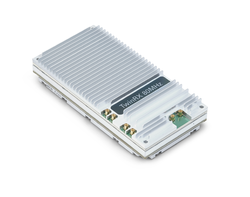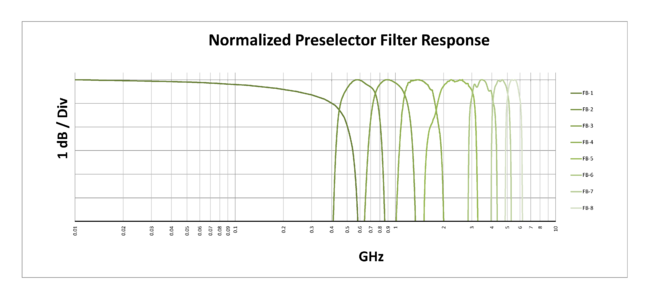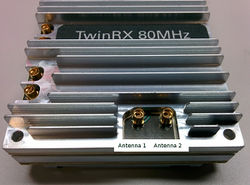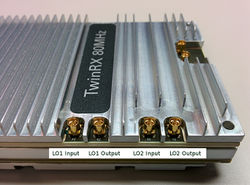TwinRX
Contents
- 1 Device Overview
- 2 Key Features
- 3 Daughterboard Specifications
- 4 RF Specifications
- 5 Hardware Specifications
- 6 Environmental Specifications
- 7 USRP Compatibility
- 8 Phase Synchronization
- 9 Schematics
- 10 RF Connectors
- 11 Local Oscillator Connectors
- 12 Software API
- 13 Drawings
- 14 Certifications
- 15 Certificate of Volatility
- 16 Downloads
Device Overview
The TwinRX daughterboard for the USRP X300 and X310 SDR platform is a two-channel superheterodyne receiver designed for high performance spectrum monitoring and direction finding applications. The receiver is tunable from 10 MHz - 6 GHz and has 80 MHz of instantaneous bandwidth per channel, providing the versatility necessary to analyze a variety of signals in multiple bands of interest. Each channel has an independent RF signal chain with preampilifiers, preselectors, and two mixer stages for superior selectivity. Users can tune the two channels independently to simultaneously monitor uplink and downlink communication with a combined bandwidth of 160 MHz. The ability to share the LO between channels across multiple daughterboards enables the phase-aligned operation required to implement scalable multi-channel phased-arrays. The receiver is capable of fast frequency hopping to detect frequency agile emitters. Configurable RF attenuation and preamplication allow users to optimize dynamic range in favor of noise figure for faint signals, or IP3 for stronger signals. UHD automatically configures the RF signal path for optimized performance in the pre-defined use cases, and provides the flexibility to adjust settings manually. Support for RFNoC on the X Series motherboard enables deterministic FPGA-accelerated computations for real-time spectrum analysis. The TwinRX daughterboard is supported by the USRP Hardware Driver™ (UHD) software API for seamless integration into existing applications.
Key Features
|
Daughterboard Specifications
Features
- 2 superheterodyne frontends (2 receive)
- 80 MHz per channel
- Independent tuning
- LO Sharing Capability
- Coherent and phase-aligned operation
- Preselection Filters
- RF Shielding
Antennas
Receive: RX1 or RX2
Gains
- Receive Gains Range: 0-93dB
Bandwidths
- TwinRX: 80 MHz per channel ( 160 MHz total )
Sensors
- lo_locked: boolean for LO lock state
Ports
The TwinRX has six MMCX RF connectors on it.
Preselector Filters
RF SpecificationsFreq Range
Noise Figure
RX Third Order Intercept (dBm)
Phase Noise (dBc/Hz)
Input/Output Impedance
Input Power Levels
Hardware Specifications
TwinRX
Environmental SpecificationsOperating Temperature Range
Operating Humidity Range
USRP Compatibility
[ERROR] [DBMGR] The daughterboard manager encountered a recoverable error in init. Loading the "unknown" daughterboard implementations to continue. The daughterboard cannot operate until this error is resolved. ValueError: TwinRX clock rate 92160000.000000 is not a multiple of the pfd freq 12500000.000000. Phase SynchronizationThe TwinRX daughterboard is capable of phase-synchronous operation, and is recommended for phase-coherent applications. Please note that the TwinRX is receive-only. The SBX and UBX daughterboards are also recommended for phase-coherent applications, and are capable of both transmit and receive operations. SchematicsThe TwinRX daughterboard is composed of two PCBs, the Intermediate Frequency (IF) board and the RF board. There are two functionally identical revisions of TwinRX at the moment. Please check the back of your TwinRX to see which you have. The schematics for TwinRX revision B should answer most possible questions. If you have any further questions please email [email protected]. TwinRX Revision A - (159685A-01)
TwinRX Revision B - (159685B-01)
File:TwinRX IF Board Rev C.pdf File:TwinRX RF Board Rev D.pdf RF Connectors
Local Oscillator ConnectorsNote: LO sharing cables are not required for a single TwinRX setup. LO sharing cables are only required with two TwinRX daughterboards in a single USRP X300/X310.
|





